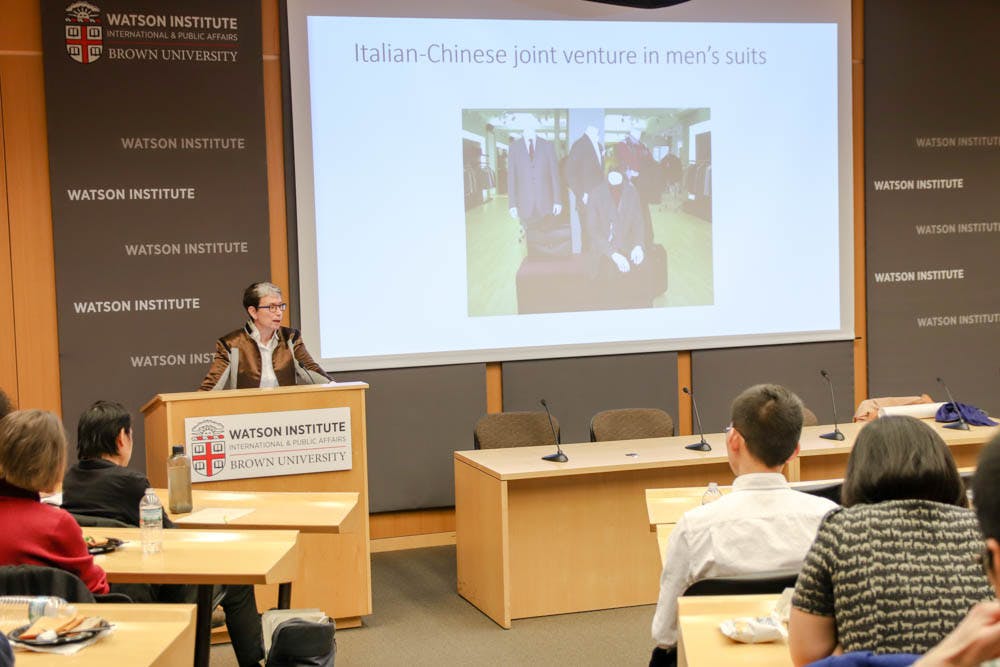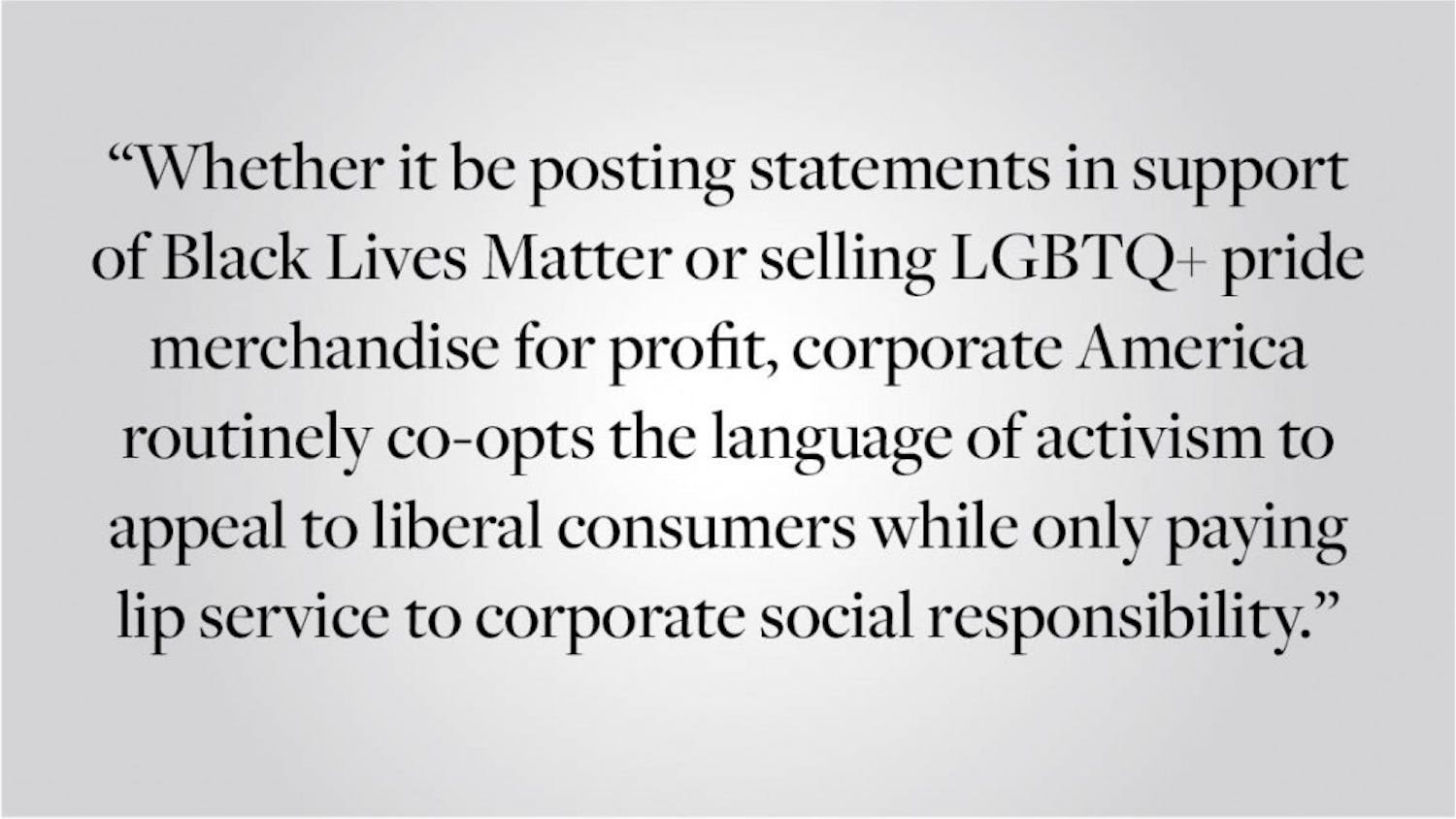For the modern woman, silk garments are a rarity.
“How many of you (women) have any silk clothing?” A smattering of hands responded. “One … two …three … four … not bad!”
At the close of the 20th century, “the increase in women’s employment meant that women no longer had time nor interest to care for silk clothing,” explained Professor Emeritus at University of California, Santa Cruz Lisa Rofel ’75. Male ownership of silk clothing also declined, she noted.
Rofel took students and faculty members on a journey through Italian-fashion textile factories in China throughout the last decades of the 20th century as she delivered the fourth lecture of the University’s East Asia Colloquium series to a crowd at the Joukowsky Forum Thursday.
Rofel’s talk drew from her latest book, “Fabricating Transnational Capitalism,” co-authored by Stanford Professor Sylvia Yanagisako. The book “is a collaborative ethnography of Italian-Chinese ventures in the fashion industry that we hope offers a new methodology for the study of transnational capitalism in a global era,” Rofel said. Rofel and Yanagisako emphasize an interdisciplinary approach in their investigation of capitalism. “We refuse to treat the economic as a domain separate from the social, cultural and historical. We emphasize instead this way in which different life projects that are not always recognized as economic converge together with the way accumulation and wealth emerges,” Rofel said.
Her research had consequences beyond the classroom. While working on the project, Rofel had to step up her own fashion game. “I did have to start learning how to dress for this project,” she admitted to laughter.
Rofel began her research in China in 1984, in the Hangzhou silk district, “just as economic reform was taking off in China’s urban center.” Rofel “witnessed the devolution of central planning, the ability of state-run silk factories to profit, the beginnings of hiring migrant labor and the desires of young urban factory workers to leave the factory and become small household businesses.” She “was interested in finding out what was happening to women workers in the context of this economic reform.”
At the same time, Yanagisako initiated research on “family firms in the silk industry” in Como, Italy. On the Italian end, “anxieties about competition from China were already pervasive,” Rofel said.
Rofel illustrated cultural tensions between Italian and Chinese fashion industrialists by describing anecdotes from her fieldwork. She has observed from interactions with fashion industrialists that “Italian-Chinese collaborations are a series of ongoing negotiations – not always smooth.”
Foreigners were not permitted to make direct arrangements with textile factories in China until the early ‘90s. Once they could, “Chinese companies were, in fact, vigorously searching for foreign production and trade partners.” But “at the same time, silk began a precipitous decline.”
The ‘90s saw China’s market economy explode as a “sea change” swept the country, Rofel explained. The growth prompted “the emergence of a new middle class who have embraced the state’s fostering of consumerism — including the consumption of Italian fashion.”
But the growth also exacerbated inequalities, including and beyond rural-urban divisions.
“The overwhelming majority of workers in the factories that produce Italian fashion clothing, as in other sectors, are migrants from the countryside,” she said. “Multinational corporations, along with the involvement of various Chinese government agencies and independent entrepreneurs have together produced the horrendous working conditions these migrants experience.” Workers are erratically paid per the piece of clothing they produce, she added — meaning some days they are not paid at all.
“China grapples with being both the sweatshop of the world and with searching for natural resources to fuel economic growth,” she added.
Rofel also shared pieces of her own history with the audience. She recalled coming to Brown the first year Pembroke merged with the rest of the University, when History concentrators were still required to study Europe. In her studies of China at the University, Rofel’s professors taught her that in China, the sense of historical consciousness runs deeper than it does in the United States. These amount to “real differences in ways that we grapple with history,” she added.
Ji Soo Hong is a second-year PhD student in History at the University. She usually tries to come to the East Asia Colloquium lectures, and yesterday’s “subject was really interesting, because I’m also really interested in transnational capitalism,” which is connected to her studies, she said. Her friend, an anthropologist, had informed her about the talk, and she jumped at the chance “to meet a really prestigious scholar” who shares her academic interests.
Nathaniel Conrad ’19 concentrates in East Asian Studies and presented his thesis in a previous Colloquium, which also discussed multi-sited ethnographies. “I came here with some questions about her and her fellow researcher’s seemingly unique method of approaching issues of capitalism, and I was really impressed … about how they approached capitalism from a very humanistic perspective,” he said.
“It’s really important to be always humanizing as much as possible … sort of abstract concepts like capitalism. You could definitely approach it by way of models. You could make very sophisticated models, and I think many have been made. But what’s very important about this kind of research … It can provide a little more of a glimpse of how these larger systems affect individuals, so that policymakers can understand them a little better and hopefully write better policies.”





